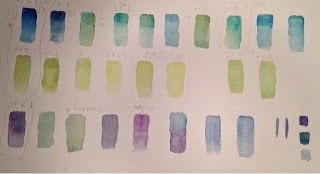Last week saw the start of a new painting of the Jade Vine,
Stongylodon macrobotrys, Family: Fabaceae ( Pea family). Completing work is always a good feeling.... and that's what I'm looking forward to doing with this piece! Painting can be a frustrating business at times but it's always best to finish, the alternative of having unfinished work lying around can be a bit depressing and a bad habit to get into. I'm currently working through all of my unfinished projects from the last 2 years and finally feel as though progress is being made.
 |
| A new Jade Vine painting underway, size 40 x 56 cm. I normally put the stems/ stalks in first but decided to start with the flowers this time, using a blue biased turqoise mix. The yellow biased mix will be added as a glaze later. |
 |
| Last years painting, a larger flower......a bit too large! |
It's been almost a year since the previous painting of the vine and I have until the end of the month to submit for the Sydney Royal Botanic Garden Florilegium project. I started over because the first one is really a bit too large for the specification...my mistake! So this one is a simplified slightly smaller painting, not that it's particularly small at 40 x 56 cm but it feels a lot smaller compared to the larger version.
I actually prefer this flower, it's the one from Durham University Botanic Garden, and although the flowers at Kew were plentiful and considerably larger, this flower had the most intense colour.
 |
| Purple creeping into the turquoise flowers, is a sign ageing |
I hobbled to Durham on crutches last March, having twisted my ankle the week before. I knew the plant was in flower as the garden manager had kept me informed of the progress before my visit. I came upon the solo flower hanging just inside the doorway of the hothouse. As I stood photographing and sketching it, I could hear people gasp as they opened the door behind me ....so vivid was the colour, it created quite a talking point! The flower was pretty much at the end of flowering period and some purples were creeping into the turquoise flowers. So here is the painting so far....more work tomorrow.
 |
| Still a long way to go but making steady progress! (Tracing paper is used to Keep the paper clean and to protect the work). |
Painting specifications
For this project there are a number of specifications. Only 100% cotton archival quality paper can be used, which is something that I always use anyway. Fabriano Artistico HP 300lb paper, is my normal paper, so this was fine. For those interested and to clarify which side to use, it's the side
without the writing, which is actually the back side of the paper, the front is the mesh side and where the writing is.
The painting has to be produced to given size specification and there are two portrait and two landscape options, I chose the largest portrait size, this is why I've chosen the smaller flower, the previous painting had a flower spike almost 60cm in length. Plants must be painted life size, so the larger spike was simply too large and I didn't want to crop it.
Paints must be ASTM lightfast rated with permanence I or II. The signature has to be in pencil , discreet , no logo style signatures are allowed.
The colour of this flower is very unusual! the basic hue is turquoise and it moves from yellow to turquoise, green, blue and violet. below are some of the colours used. I decided to start with a slightly more blue biased mix and add the more yellow biased mix on top.
 |
| Winsor Blue Green shade plus Aureolin seems the best option for the mix and both have ASTM II. But in the end I went for Hansa Yellow light because I don't like Aureolin. Also used is Ultramarine violet and some Cobalt Turquoise. Making sure the chosen colours have the correct light fast rating. |
In it's native habitat in the Philippines the jade vine is pollinated by bats, the green actually appears to glow at night, and attracts the pollinators, most bat pollinated plants which are white.To find out more about it
click here
 |
| Some fallen flowers collected from Kew and taken back to the hotel for investigation. Bats hang upside down on the flower and drink the nectar as it pours out of the flowers and their heads brush against the pollen as they do so, as they move from plant to plant cross pollination occurs when the pollen brushes against the stigma. |
|
 |
| Not exactly at its best but still worth investigating! A flower from Durham |
I expect this painting will keep me busy for the next week or so! That's it for this week, will be interesting to see how much I actually get done by the same time next week!


























I love this blog. It's so. Interesting and adding a picture of the flower in addition really highlights the significance of the work you are doing. The painting is coming along beautifully. Good luck with the rest of it. Interesting what you said about the necessity for 100% cotton. It also seems better to work with than the Classico.
ReplyDeleteGreat blog Dianne - I always learn something, thanks and good luck - can't wait to see more.
ReplyDeleteAn amazing plant and flower - almost seems fake somehow because of the colour but I guess that's Mother Nature showing how clever she is ...
ReplyDeleteThe painting is beautiful.
Thank you Dianne for sharing such beautiful work.
ReplyDeleteWhat an amazing and interesting plant, and your depiction of it is quite elegant. I was interested to read about the specs of the exhibition--thanks for explaining and showing your process.
ReplyDelete